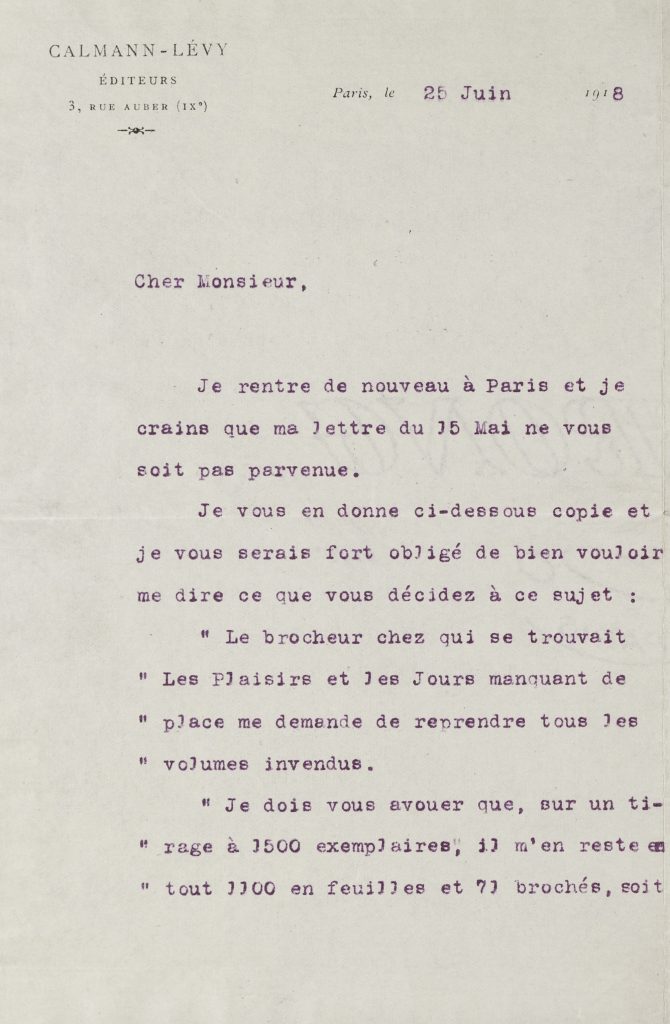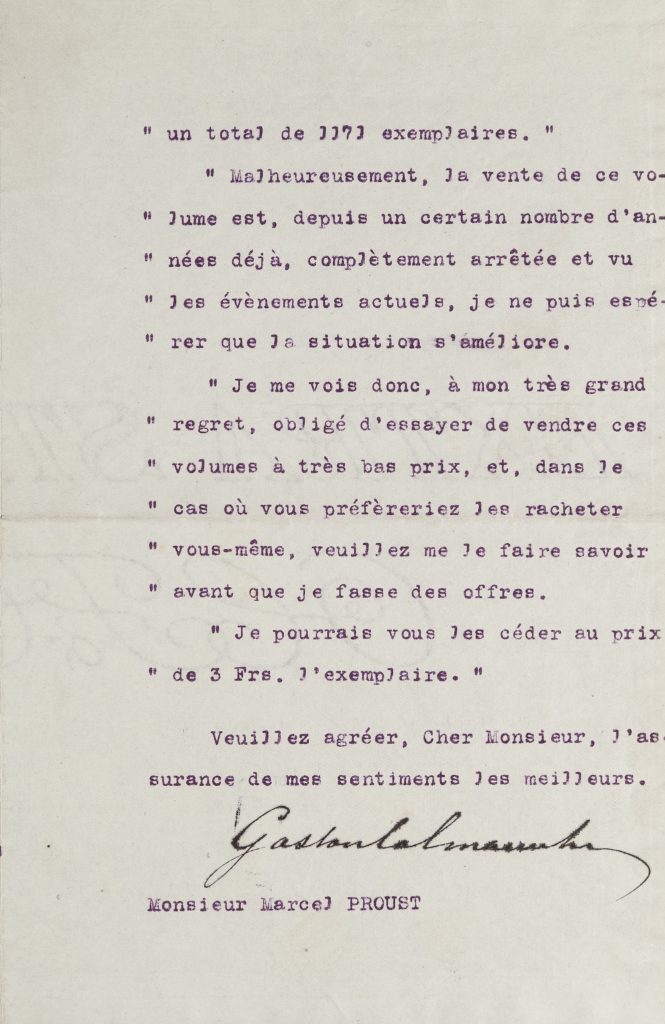By Anne Mutidjo, graduate student in French
Letter from Gaston Calmann-Lévy to Marcel Proust, 25 June 1918 [1]
CALMANN-LÉVY
PUBLISHERS
3 AUBER STREET (IXth)
Paris, June 25, 1918
Dear Sir,
I am back in Paris and I fear that you did not receive my letter dated May 15th [2].
You will find a copy of it below and I would be very obliged if you would tell me what you decide regarding this matter [3]:
“The binder who was keeping Les Plaisirs et les Jours [4], lacking space, asked me to take back all the unsold volumes.”
“I must confess that, out of a print run of 1500 copies, I still have 1100 of them in sheets and 71 bound, for a total of 1171 copies.”
“Unfortunately, the sale of this volume has, for a number of years already, completely stopped [5] and given current events, I cannot hope to see the situation improve.”
“Seeing no other option, and with great regret, I must attempt to sell these volumes at very low price: and, should you be interested in buying them back yourself instead, please let me know before I start making offers.”
“I could let you have them for 3 Fr[anc]s per copy.”
Sincerely yours,
Gaston Calmann-Lévy
[1] Letter catalogued as Proust-Series 1 / Lefebvre 104, Rare Book and Manuscript Library, University of Illinois at Urbana-Champaign.
[2] Proust did in fact receive Calmann-Lévy’s earlier letter from 15 May 1918, as he mentions it in a letter to Madame Scheikévitch on [28 May 1918] (Corr, vol. XVII, p. 262). That first letter from Calmann-Lévy has survived: it recently went up for auction in 2017 (Aguttes, Les collections Aristophil, vente inaugurale, Paris, 20 December 2017, lot 47). Proust appears to have left it unanswered until he received this second letter.
[3] Proust, offended, responded to Calmann-Lévy with an indignant, nineteen-page long letter on 26 June 1918. That letter, which remains unpublished, was sold at auction in 2014 (Sotheby’s, Livres et manuscrits, Paris, 19 June 2014, lot 117).
[4] Les Plaisirs et les Jours [Pleasures and Days], from 1896, was Proust’s first book, a collection of short stories and poems. It had a mixed reception: critics overall wrote positive reviews, but the book’s luxury format and price, “nearly four time the normal price for a book,” proved to be “a publishing and public relations fiasco” (see Carter, p. 214-216).
[5] In his lengthy response, Proust contests Calmann-Lévy’s statement.
Written a few months after the menacing 1918 Spring Offensive of the Germans through the Northern French region of the Somme, this letter from the publisher Gaston Calmann-Lévy to Marcel Proust illustrates not only the unreliability of communications during the war (as Calmann-Lévy imagines his earlier letter might somehow not have reached Proust), but also the difficult conditions that the war imposed on editors and authors alike.
Calmann-Lévy was a renowned publishing house created in 1841 or 1842, and directed by the brothers Lévy. Authors such as Sand, Hugo, and Baudelaire were published there. It was only following a recommendation from the writer Anatole France (then much more famous than the young Proust) that Calmann-Lévy agreed to publish Les Plaisirs et les Jours in 1896. This first book was not the success Proust had hoped for [6].
When Calmann-Lévy proposes to sell the remaining copies of Les Plaisirs et les Jours for only 3 francs each in 1918, Proust is livid. He responds to the publisher in a lengthy nineteen-page letter, pointing out that the volume included several illustrations and original watercolors from Madeleine Lemaire and a preface written by Anatole France himself, all of which had been executed free of charge. Proust reminds the publisher that he never earned royalties on the book [7], and that he himself buys about five copies a year, so that the sale of these volumes cannot have stalled (Proust liked to give copies of this first publication to his friends and acquaintances, as we see for instance in the post-script to this 1915 letter to Lionel Hauser). Proust contests the insinuation that his book had been bad business for the publishing house. In fact, he writes to Calmann-Lévy that the mixed reception of this early work has been more harmful to his own reputation as a writer: “for many years it made me look like an amateur” [8].
In hindsight, it is ironic to see Calmann-Lévy write that he “cannot hope to see the situation improve”: just a year later in 1919, Proust would win the Prix Goncourt, and his fame, along with interest in earlier work, would increase greatly.
In his response to Calmann-Lévy, Proust gives us insight into his future projects. He mentions a more affordable upcoming reprint of Les Plaisirs et les Jours, which he only wants to make available to the public after his new publisher, the Nouvelle Revue française, finishes printing “Swann” [9], a process that is being delayed because “the war is slowing down the printing” [10]. This element is not only an illustration of the complications brought about by the conflict; it also highlights how the war shaped Proust’s publishing strategies.
[6] See Carter, Marcel Proust, A Life, chapter 7 (p. 203-231) for more information on Les Plaisirs et les Jours and its reception.
[7] This is confirmed by a September 1897 letter from Proust’s friend Robert de Flers: “Regarding your [Proust’s] royalties, Mr. Gaston [Calmann-Lévy] and Mr. Hubert say that no contract was made between you and them, only a mutual agreement that you would only receive monetary compensation the day the publishing costs would be completely covered” (“Quant à la question de tes droits d’auteurs M. Gaston et M. Hubert disent qu’il n’y a eu aucun traité passé entre vous mais une convention tacite en vertu de laquelle tu n’aurais droit à quelque rémunération pécuniaire que le jour où les frais de l’édition seraient entièrement couverts”). See Corr., vol. II, p. 218. Translation by Anne Mutidjo.
[8] On the question of whether the book was “bad business,” see Proulx, p. 242-244.
[9] Proust often referred to the whole novel as “Swann,” but it is possible that he is here talking about À l’ombre des jeunes filles en fleurs [In the Shadow of Young Girls in Flower], which finished printing at the end of November 1918, after the armistice (Carter, p. 679).
[10] “La guerre en rend l’impression plus lente.” Proust, letter to Gaston Calmann-Lévy, 26 june [1918]. Excerpts of Proust’s letter are transcribed in a 2014 sale catalog and in Pyra Wise, “Les ventes,” Bulletin d’informations proustiennes 45 (2015), p. 210-211.
Works cited
Carter, William C. Marcel Proust, A Life. New Haven: Yale University Press, 2000.
Proulx, François. “‘Irregular’ Kin: Madeleine Lemaire and Reynaldo Hahn in Les Plaisirs et les Jours.” Proust and the Arts. Eds. C. McDonald and F. Proulx. Cambridge University Press, 2015. 232-251.
Proust, Marcel. Correspondance. Ed. Philip Kolb. Paris: Plon (21 vols.), 1970-1993.
Wise, Pyra. “Les ventes.” Bulletin d’informations proustiennes 45 (2015), 201-230.

